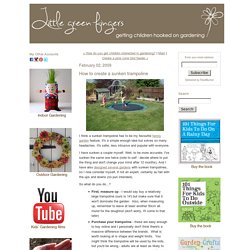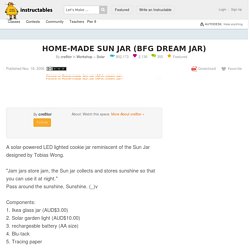

How to create a sunken trampoline - little green fingers. I think a sunken trampoline has to be my favourite family garden feature.

It's a simple enough idea but solves so many headaches. It's safer, less intrusive and popular with everyone. I have sunken a couple myself. Well, to be more accurate, I've sunken the same one twice (note to self - decide where to put the thing and don't change your mind after 12 months). And I have also designed several gardens with sunken trampolines, so I now consider myself, if not an expert, certainly au fait with the ups and downs (no pun intended). So what do you do...? First, measure up - I would say buy a relatively large trampoline (ours is 14') but make sure that it won't dominate the garden. And that's it, except to say, sunken trampolines might be safer, but not so safe that you shouldn't supervise very carefully. Oh and if you want to see a couple of films about putting in sunken trampoines and how to maintain them, check these out below: How to make your own Farm Fountain / howto01.
Home-made Sun Jar. AdWords We use AdWords to deploy digital advertising on sites supported by AdWords.

Ads are based on both AdWords data and behavioral data that we collect while you’re on our sites. The data we collect may include pages you’ve visited, trials you’ve initiated, videos you’ve played, purchases you’ve made, and your IP address or device ID. This information may be combined with data that AdWords has collected from you. We use the data that we provide to AdWords to better customize your digital advertising experience and present you with more relevant ads. LiveRamp We use LiveRamp to deploy digital advertising on sites supported by LiveRamp. UpSellIt We use UpSellIt to help create a more streamlined shopping cart experience. Doubleclick We use Doubleclick to deploy digital advertising on sites supported by Doubleclick.
RocketFuel We use RocketFuel to deploy digital advertising on sites supported by RocketFuel. Twitter We use Twitter to deploy digital advertising on sites supported by Twitter. Reusing Lightbulbs: as planters or mini terrariums. Lesson Plan for Making a Speaker Laboratory. ©1995 The Regents of the University of California by Regan Lum Introduction: A speaker is a device that converts an electronic signal into sound.

The speaker you will build (see figure 1) consists of a Styrofoam or paper cup, a coil of wire, a permanent magnet, and a signal source. The electronic signal goes through the coil and creates a varying electromagnet. Figure 1 Purpose: In this laboratory, you will explore how a speaker works. Materials: 1 permanent magnet 2 feet of wire 1 pencil tape or glue 1 Styrofoam or paper cup 1 signal source (tape player) 1 plug with alligator clips for tape player Procedure: Assemble material as shown in figure 1. Leaving about 10 centimeters on the end, wrap the wire around a pencil to make a wire coil and tape or glue it to the bottom of the cup. Conclusion Does the volume control on the tape player work on your speaker? Return to CEA Science Education Home Page.